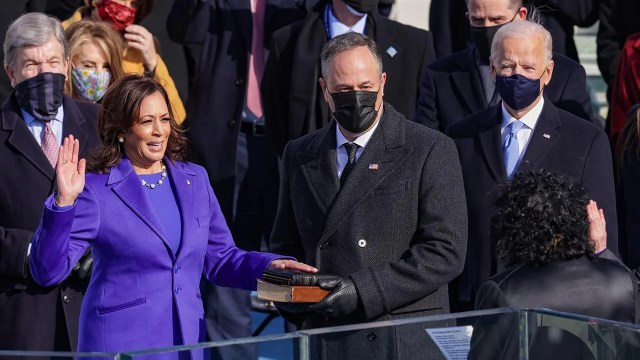
Twelve years after Barack Obama made history as the first Black U.S. president, a Black woman was sworn in as vice president of the United States following the election of Joe Biden. Kamala Harris, who is of mixed Jamaican and Indian heritage, is the first Black American, first person of Asian descent and first woman to hold the second-highest office in the country. Harris’ election represented another advance in the slow but steady progress Black Americans have made in recent decades in gaining a greater foothold in political leadership, particularly in the U.S. House of Representatives and in the Cabinets of recent presidents. But they have lagged in the Senate and in governorships.
How we did this
This analysis builds on earlier Pew Research Center work analyzing the share of elected officials and other leaders in politics who are Black.
The data on Black U.S. House members from 1965 to 2019 is based on the Brookings Institution’s “Vital Statistics on Congress.” The number for 2021 is drawn from the U.S. House of Representatives Press Gallery. These figures show the number of Black representatives on the first day of each congressional session and do not include nonvoting delegates or commissioners.
Historical data on the share of Cabinet members who are Black was previously gathered from Inside Gov, a now-defunct online source for information on the U.S. government. Data on the Biden administration’s Cabinet comes from the White House and news reports. In this analysis, the Cabinet includes the vice president and heads of federal agencies; it does not include Cabinet-level officials. Figures are percentages because the number of Cabinet positions has fluctuated across administrations. The figures shown are based on the maximum number of Black Cabinet members serving concurrently in a given administration out of the total number of Cabinet members in that administration.
The analysis also cites one question from a Pew Research Center survey of 9,654 U.S. adults conducted in June 2020. Here are the questions asked in that survey, along with responses, and its methodology.
Many Black Americans view political representation as a potential catalyst for increased racial equality, according to a June 2020 Pew Research Center survey. Four-in-ten Black adults said that working to get more Black people elected to office would be a very effective tactic for groups striving to help Black Americans achieve equality. White adults were less likely to view this as an effective way to bring about increased racial equality (23% said it would be very effective).
Data from the past several decades reveals the upward yet uneven trajectory of Black political leadership in America. In 1965, there were no Black U.S. senators or governors, and only five members of the House of Representatives were Black. As of 2021, there is greater representation in some areas – 57 House members in the new Congress are Black (not including nonvoting delegates and commissioners), putting the share of Black House members (13%) about on par with the share of the overall U.S. population that is Black. But in other areas, there has been little change: There are three Black senators – the same number as in 2019 – and no Black governors.
The first Black U.S. senator, Hiram R. Revels, a Republican from Mississippi, was chosen by his state’s Legislature to fill an empty seat. He served for a year, from 1870 to 1871. In total, 11 Black Americans have served in the Senate, including three currently in office. This is the same number as in the previous Congress, since Harris moved from the Senate to the White House and Raphael Warnock, a Democrat, became the first Black senator from Georgia. Until 2013, no two Black senators had been in office at the same time.
The share of Black members in a presidential Cabinet was at or above parity with the population during the Clinton and George W. Bush administrations and Obama’s second term, and this will be the case if all of Biden’s nominees are approved. But there was only one Black Cabinet secretary during the Trump administration, and the same was true during Obama’s first term.
The current 117th Congress includes 57 Black representatives, a record high and a large increase since 1965. Only two of these 57 representatives are Republicans. Two nonvoting delegates, representing the District of Columbia and the U.S. Virgin Islands, are Black. Only five representatives were Black in 1965, and all were Democrats.
[chart id=”383520″]
The highest level of Black representation in a presidential Cabinet occurred during Bill Clinton’s first term, when four out of 15 Cabinet appointees were Black. Since then, the share of the Cabinet that is Black has fluctuated. In Obama’s first term and Donald Trump’s presidency, only one Cabinet member was Black, but under George W. Bush’s first term and Obama’s second, the share of the Cabinet that was Black exceeded the Black share of the overall U.S. population. If Biden’s slate of nominees is confirmed by the Senate, his Cabinet will include three Black members – Harris as vice president, Lloyd Austin as the first Black secretary of defense, and Marcia Fudge as secretary of housing and urban development.
[chart id=”383519″]
There are no Black governors in office today, and there have been none since Deval Patrick retired in 2015. In fact, there have been only four in U.S. history. Pinckney Pinchback served as a governor of Louisiana for 35 days in the 1870s following Henry Clay Warmoth’s impeachment. Virginia, Massachusetts and New York each had a Black governor during the 1990s and 2000s – Douglas Wilder, Deval Patrick and David Paterson, respectively. The latter two were the first to serve simultaneously, from 2008 to 2010. Three Black candidates – including two seeking to become the first Black female governor – are part of a crowded field vying to be elected governor of Virginia in November 2021.
Note: This is an update of a post originally published June 28, 2016, and previously updated on Jan. 18, 2019.

